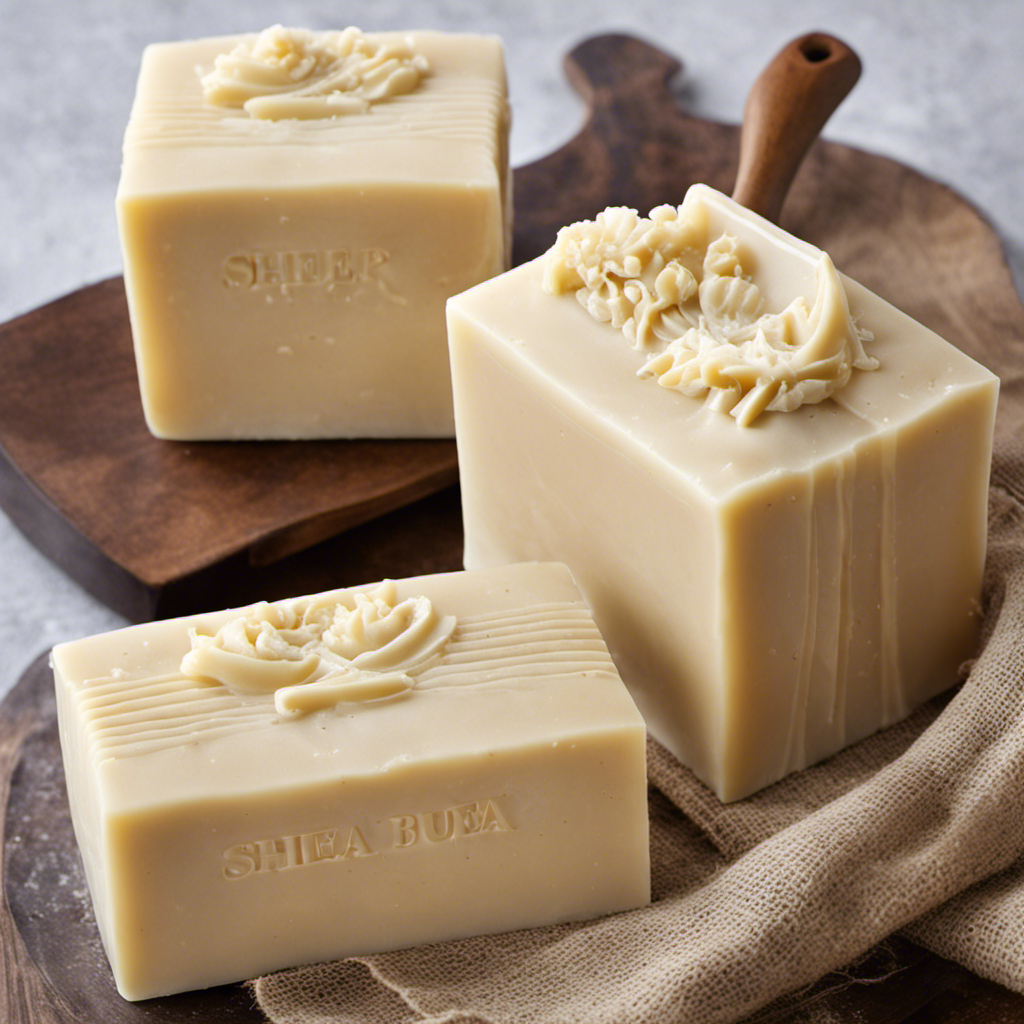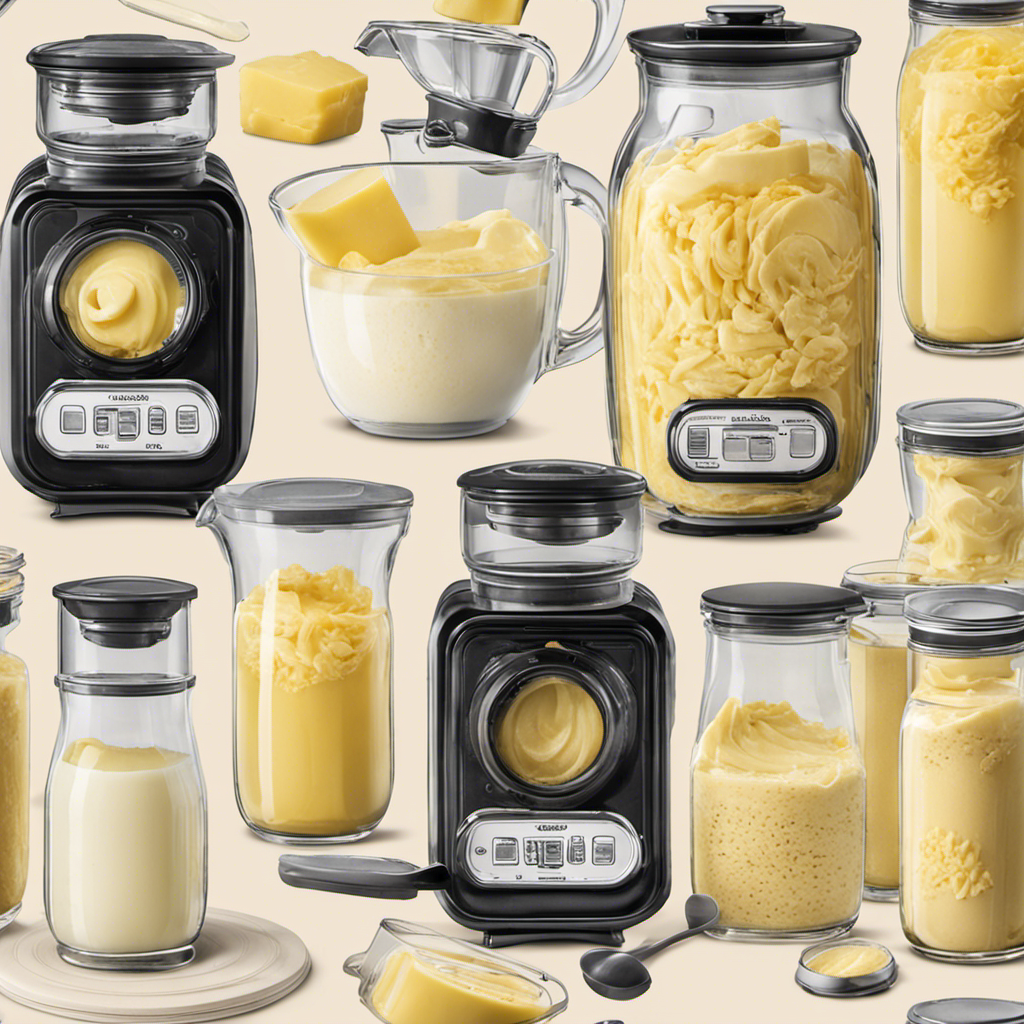I’ve found a way to boost the taste of my butter, and I’m excited to reveal it to you.
In this article, I’ll guide you through the process of making salted butter from unsalted. It’s a simple technique that adds a burst of savory goodness to your spreads and recipes.
From gathering the ingredients to adjusting the salt levels to your taste, I’ll provide all the steps you need to create your own homemade salted butter.
Get ready to elevate your culinary creations to a whole new level.
Key Takeaways
- Soften unsalted butter by leaving it at room temperature, grating it, or microwaving it in short bursts.
- Experiment with different types of salt, such as kosher salt, sea salt, or Himalayan salt, to incorporate into the butter.
- Adjust the saltiness of the butter according to personal preference and intended use.
- Shape and store the salted butter in an airtight container in the refrigerator, or freeze it for longer storage.
Gathering the Ingredients
Now, you’ll need to gather the ingredients for making salted butter from unsalted.
Salted butter has the benefit of adding flavor and enhancing the taste of various dishes.
To make salted butter, you will need unsalted butter, salt, and a mixing bowl.
It is essential to use good quality unsalted butter for the best results.
You can choose from various alternative salt options such as kosher salt or sea salt, depending on your preference.
These salts provide a unique flavor profile to the butter.
Make sure to have enough salt on hand, as you can adjust the saltiness according to your taste.
Once you have gathered these ingredients, you are ready to move on to the next step in the process of making salted butter.
Softening the Unsalted Butter
To soften unsalted butter, you can leave it at room temperature for a few hours. This allows the butter to become more malleable and easier to work with. However, if you’re short on time, there are other softening techniques you can use.
One option is to grate the cold butter using a cheese grater. This increases the surface area, helping it soften faster. Another technique is to microwave the butter in short bursts, checking and stirring it frequently to ensure it doesn’t melt.
When it comes to incorporating the salt, there are different types you can use. Some common options include kosher salt, sea salt, and Himalayan salt. Each type of salt has its own distinct flavor and texture, so choose one that suits your taste preferences.
Moving on to incorporating the salt, there are a few different methods you can use.
Incorporating the Salt
If you’re looking to add some flavor to your softened butter, you can incorporate the salt using a few different methods.
Adjusting the saltiness of your butter is a matter of personal preference, so it’s important to find the right balance.
There are various types of salt you can use to achieve different flavors. For a classic option, table salt works well and is readily available. However, if you want to elevate the taste, you can try using sea salt or kosher salt, which have a slightly different flavor profile.
To incorporate the salt, you can simply sprinkle it over the softened butter and mix it in thoroughly. Alternatively, you can dissolve the salt in a small amount of water or melted butter before adding it to the softened butter.
Experiment with different types of salt and amounts to find the perfect level of saltiness for your taste buds.
Adjusting Salt Levels to Taste
Finding the perfect level of saltiness for your taste buds is a matter of personal preference when adjusting salt levels to taste. Here are three things to consider when finding the right balance of salt for your homemade salted butter:
-
Start with a small amount: Begin by adding a pinch of salt to your unsalted butter and mix well. Taste the butter and gradually add more salt if desired. Remember, it’s easier to add more salt than to take it away.
-
Consider the intended use: Think about how you plan to use the salted butter. If you’re using it for baking, you might want a slightly saltier taste to enhance the flavors. For spreading on toast or using in savory dishes, a milder saltiness might be preferred.
-
Be mindful of health concerns: While salted butter can add flavor, it’s important to be conscious of your salt intake. Excessive consumption of salt can contribute to high blood pressure and other health issues. Moderation is key.
Finding the right balance of salt in your homemade salted butter can enhance your culinary creations while considering your personal taste and health concerns.
Mixing the Butter and Salt
When it comes to adding salt to a recipe, there are a few key points to keep in mind.
First, it’s important to follow salt measurement tips to ensure you’re using the right amount.
Secondly, incorporating salt evenly throughout the dish is crucial for balanced flavor.
Salt Measurement Tips
Here’s a tip on how to measure salt for making salted butter from unsalted.
When it comes to salt measurement techniques, precision is key. Here are three helpful tips to ensure you get the right amount of salt in your homemade salted butter:
-
Use a kitchen scale: To accurately measure salt, it’s best to use a kitchen scale. This allows you to measure the exact weight of the salt, ensuring consistency in your butter.
-
Stick to the recipe: If you’re following a specific recipe for making salted butter, be sure to measure the salt according to the instructions. Different recipes may call for different amounts of salt, so it’s important to follow the recipe’s guidelines.
-
Choose the right salt: When making salted butter, it’s crucial to choose the right type of salt. Depending on your preference, you can use kosher salt, sea salt, or table salt. Each type of salt has a slightly different flavor profile, so choose one that complements your taste.
Incorporating Salt Evenly
Now that we have learned about measuring salt accurately, let’s move on to incorporating it evenly into our unsalted butter.
To ensure that the salt is evenly distributed, start by softening the unsalted butter to room temperature. Next, sprinkle the desired amount of salt evenly over the butter. Using a fork or spatula, gently mix the salt into the butter, making sure it is thoroughly combined. This will ensure that each bite of your homemade salted butter delivers the perfect amount of flavor.
The benefits of adding salt to unsalted butter are numerous. Salt enhances the overall taste and can bring out the natural flavors of the butter. It also acts as a preservative, extending the shelf life of the butter.
With our butter now salted to perfection, it’s time to move on to the next step: taste testing for balance.
Taste Testing for Balance
To ensure that the flavors are balanced, you can take a small taste of your homemade butter and adjust the salt accordingly. Here are some taste testing methods to help you find the perfect salt to butter ratio:
-
Start with a small amount of butter on a spoon and taste it on its own. This will give you a baseline of the butter’s natural flavor.
-
Gradually add a pinch of salt to the butter and mix it in. Taste it again to see how the salt enhances the flavor. Repeat this process until you achieve the desired level of saltiness.
-
Consider the intended use of the salted butter. If you plan to use it for baking or cooking, keep in mind that the flavors may change when incorporated into a recipe.
Once you have achieved the ideal balance of salt and butter, you can move on to the next step of shaping the salted butter.
Shaping the Salted Butter
You’ll want to shape the salted butter into a log or a cube for easy storage and use. Shaping the butter is a simple process that can be done using shaping techniques or decorative butter molds.
To shape the butter into a log, start by placing the softened butter onto a sheet of parchment paper. Roll the butter into a cylinder shape, using the parchment paper to help you create a tight log. Once the butter is shaped, twist the ends of the parchment paper to seal the log and refrigerate until firm.
Alternatively, you can use decorative butter molds to shape the butter into various designs. Simply press the softened butter into the mold, making sure to fill all the crevices, and then refrigerate until firm.
Shaping the salted butter not only makes it easier to store and use, but it also adds a touch of elegance to your dining table.
Storing the Salted Butter
For easy storage, keep the shaped salted butter in an airtight container in the refrigerator. Storing salted butter properly is essential to preserve its freshness and flavor. Here are a few tips to help you store your salted butter effectively:
-
Choose the right container: Opt for airtight containers or resealable bags to prevent air and moisture from reaching the butter. This will help maintain its texture and prevent it from absorbing unwanted odors from the fridge.
-
Keep it in the refrigerator: Salted butter should always be stored in the refrigerator, as it helps to keep it cool and extend its shelf life. Avoid storing it in the door of the fridge, as the temperature there can fluctuate.
-
Freeze for longer storage: If you have excess salted butter that you won’t be using soon, consider freezing it. Wrap it tightly in plastic wrap or place it in a freezer-safe container to prevent freezer burn. When you’re ready to use it, thaw it in the refrigerator overnight.
Using the Salted Butter in Recipes
Once thawed, the frozen salted butter can be used in various recipes for added flavor and richness. Using salted butter in baking can enhance the taste of cookies, cakes, and pastries. The salt in the butter helps to balance the sweetness and brings out the flavors of other ingredients. It creates a delicious and savory depth to the baked goods.
Additionally, adding salted butter to savory dishes like sautéed vegetables, mashed potatoes, or pasta sauces can elevate their taste by adding a hint of saltiness and richness. The butter melts beautifully, coating the ingredients and enhancing their flavors.
It is important to note that when using salted butter in recipes, it is advisable to reduce or omit any additional salt called for in the recipe to avoid over-salting.
Now, let’s move on to some tips and tricks for making salted butter from unsalted.
Tips and Tricks for Making Salted Butter From Unsalted
To give unsalted butter a savory kick, simply mix in a pinch of salt for a homemade version of salted butter.
Making your own salted butter has several benefits. Firstly, you have control over the amount of salt you add, allowing you to customize the taste to your liking.
Secondly, incorporating other seasonings into the butter, such as herbs or spices, can create unique flavor profiles that can enhance your dishes.
Finally, homemade salted butter is often fresher and creamier than store-bought versions, as it can be made with high-quality ingredients.
To make your homemade salted butter even more delicious, try experimenting with different types of salt, like sea salt or flavored salts. Get creative and enjoy the flavorful results!
Frequently Asked Questions
How Long Does It Take for Unsalted Butter to Reach Room Temperature for Softening?
It usually takes about 30 minutes for unsalted butter to reach room temperature for softening. If you need to soften it quickly, you can cut it into smaller pieces or microwave it in short intervals. Alternatively, you can use salted butter to make salted butter.
Can I Use Any Type of Salt for Making Salted Butter?
Using different types of salt for making salted butter will impact the flavor. The choice of salt can be compared to choosing spices for a dish, as each salt adds a unique taste.
How Much Salt Should I Add to Unsalted Butter?
To properly store homemade salted butter, you can keep it in an airtight container in the refrigerator. The benefits of using salted butter in baking include adding flavor and enhancing the overall taste of your baked goods.
Can I Use a Food Processor to Mix the Butter and Salt Together?
Yes, you can use a food processor to mix the butter and salt together. It’s an alternative method for softening unsalted butter and creating personalized salted butter. Experiment with different amounts of salt to find your desired taste. Keep in mind the shelf life of homemade salted butter at room temperature.
How Long Can I Store Homemade Salted Butter in the Refrigerator?
I can store homemade salted butter in the refrigerator for up to two weeks. It’s important to keep it in an airtight container to prevent it from absorbing any odors.
Conclusion
In conclusion, making salted butter from unsalted is a simple process that can elevate your culinary creations. By incorporating the right amount of salt and adjusting it to taste, you can create a perfectly balanced butter that adds flavor to any dish.
Just like a pinch of salt enhances the taste of a meal, making salted butter from unsalted can transform your recipes from ordinary to extraordinary. So go ahead, try this technique and let your taste buds dance with delight!










